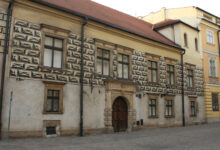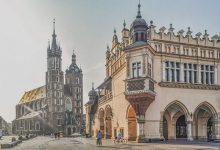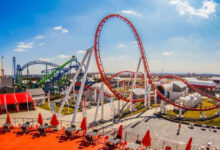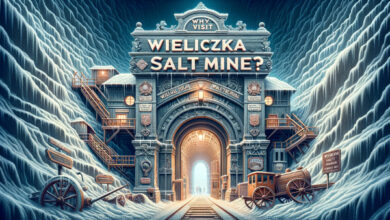The Wieliczka Salt Mine, also known as the “Wieliczka” Salt Mine, is a historic and fascinating site located in the southern region of Poland.
This UNESCO World Heritage Site has attracted curious visitors from around the globe for hundreds of years. Delving deep into its underground chambers, tourists can experience a unique world carved from rock salt, featuring impressive geological formations, charming statues, and even serene underground lakes.

Within the mine, there are various routes that allow travellers to see different aspects of the subterranean world.
The Tourist Route takes visitors through a collection of breathtaking chambers, such as the St Kinga’s Chapel, while the Miners’ Route offers a more hands-on experience that traces the steps of historical miners.
It is essential for potential visitors to be aware of the mine’s opening hours and any possible closures on public holidays to make the most of their visit to this awe-inspiring marvel.
The Wieliczka Salt Mine provides a unique glimpse into the artistic and geological wonders concealed beneath the earth’s surface.
With an array of attractions and activities to suit various interests, this extraordinary site continues to captivate travellers seeking a truly unforgettable experience.
Table of Contents:
Wieliczka History
18th and 19th Century
In the 18th and 19th centuries, the Wieliczka Salt Mine underwent significant transformation. Thanks to advances in mining techniques and technology, it became one of the world’s largest and most profitable salt mines.
The mine, located in the town of Wieliczka, Lesser Poland Voivodeship, near Kraków, boasts nearly 300 kilometres of tunnels across nine levels and is one of the oldest of its type in Europe.
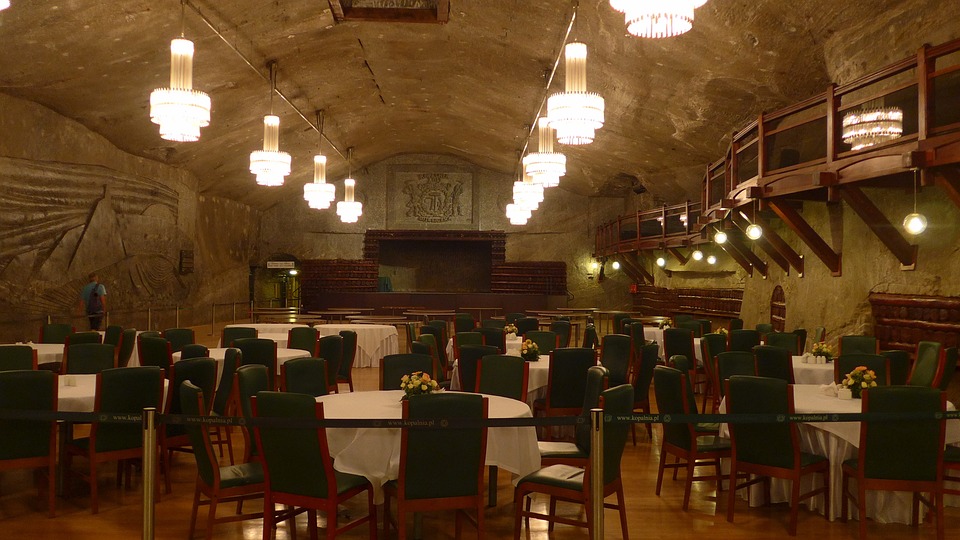
World War II
During World War II, Wieliczka played a significant role as the occupying forces sought to exploit its resources.
The Nazis converted parts of the mine into an underground facility for the production of war materials.
Despite this dark chapter in the mine’s history, the salt mine has since been largely restored and has regained its prominence as a unique historical site and tourist attraction.
Saltworks Castle
The Saltworks Castle, situated in the town square of Wieliczka, was constructed by Casimir III the Great in the 14th century.
This magnificent structure served as the centre of the town’s salt production operations and, over the years, became a significant symbol of the region’s salt mining heritage.
Later, during the First Partition of Poland, the castle fell into disrepair but has since been restored and now houses a museum dedicated to the history of salt mining in the region.
First Partition of Poland
The Wieliczka Salt Mine was directly impacted by the historical event known as the First Partition of Poland in 1772.
It was during this period that the mine’s operations were transformed and expanded by the occupying forces. This new era of imperialism, however, ultimately contributed to the mine’s survival and growth into the world-renowned cultural and historical site it is today.
In summary, the historical significance of Wieliczka and its salt mine is intertwined with major events in Polish and European history.
Both the advances of the 18th and 19th centuries and the challenging times of World War II revealed the resilience and perseverance of the region.
The rich heritage of the mine, its castle, and the key historical events they witnessed serve as a fascinating insight into the development of Wieliczka and the wider region in which it sits.
Wieliczka UNESCO World Heritage Site
The Wieliczka Salt Mine is a UNESCO World Heritage Site located in southern Poland. It is an important monument of world material culture and has been a valuable source of salt since the 13th century.
The mine is situated on the same geological rock salt deposit as the Bochnia Royal Salt Mine, and together, they represent one of the earliest and most significant European industrial operations.
Salt Mine Monuments
Within the Wieliczka Salt Mine, visitors can witness intricate salt sculptures and magnificent statues made by miners throughout the centuries. The mine’s expansive chambers house various impressive monuments, including:
- The Chapel of St. Kinga: A subterranean church entirely carved out of salt, featuring elaborate salt chandeliers, walls adorned with religious figures and scenes, and an awe-inspiring altar.
- The Erazm Barącz Chamber: Showcasing a collection of salt-carved reliefs depicting mythical and historical figures and events.
- The Józef Piłsudski Chamber: Home to an impressive statue of the Polish statesman, also made entirely of salt.
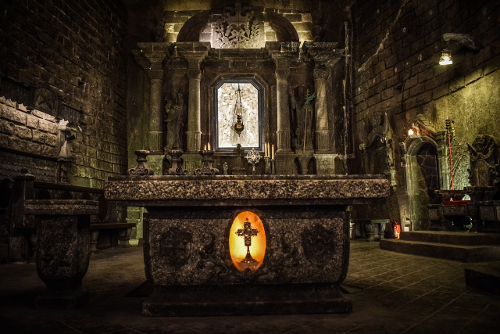
Famous Visitors
Wieliczka Salt Mine has attracted many notable visitors from around the world throughout its rich history. Here are a few famous names who have explored its depths:
- Nicolaus Copernicus: The renowned astronomer visited the mine in 1493, where he signed his name on a wall in one of the chambers.
- Johann Wolfgang von Goethe: The famous German writer and statesman toured the mine in 1790, appreciating its artistic and historical significance.
- Fryderyk Chopin: The celebrated Polish composer and pianist visited Wieliczka in 1833 and was inspired by the mine’s captivating atmosphere.
- Ignacy Paderewski: The Polish pianist, composer and politician paid a visit to the mine in 1926 as an avid supporter of Poland’s cultural heritage.
- Bill Clinton: The former US president explored the mine in 1994, becoming one of the many political leaders who have experienced its enchanting allure.
Mine Tours and Activities
Guided Tours
At the Wieliczka Salt Mine visitors can participate in informative guided tours through the fascinating world of one of the most popular tourist attractions in the region.
Tours generally involve a walk through the historic tunnels, salt deposits, and magnificent underground chambers.
Visitors must book their tours in advance, led by experienced tour guides who share interesting information about the mine’s history and remarkable features.
The mine is easily accessible, located near the A4 highway, making it convenient to reach from various points within Southern Poland.
More info Wieliczka Salt Mine Tour
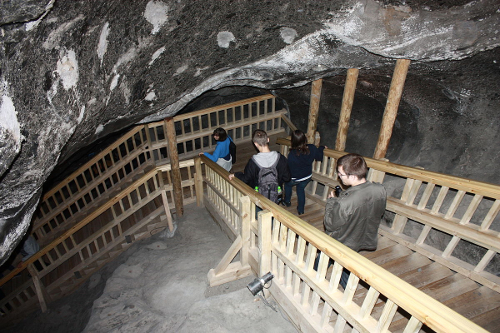
Miners’ Route
The Miners’ Route allows visitors to embrace their inner explorer and venture deep into the Wieliczka Salt Mine.
This unique experience sees tourists transform into novice miners, dressing in traditional mining attire and overcoming the darkness using a lamp to guide them.
On the Miners’ Route, participants will learn about the underground trade, the mine’s brine extraction process, and the contributions of historic figures such as Siuda Baba and Gabriel Wojniłłowicz.
This interactive and engaging journey offers an extraordinary and unforgettable adventure that awakens one’s senses.
Pope John Paul II Route
Dedicated to the memory of Pope John Paul II, who visited the mine in 1999, the Pope John Paul II Route showcases the religious and spiritual aspects of the Wieliczka Salt Mine.
This route leads visitors through breathtaking salt chapels, some adorned with remarkable organic salt sculptures and intricate carvings.
On this path, tour guides share the significant connections between Pope John Paul II, the salt mine, and the local community.
The Pope John Paul II Route offers a fascinating blend of history, spirituality, and artistry, making it a must-see for visitors interested in the rich heritage of the Wieliczka Salt Mine.
Don’t forget to read:
Jewish History in Wieliczka
Jewish Community
In Wieliczka, the Jewish community has a rich history dating back to the 19th century. Jewish shareholders allocated shares in a company established in 1843 to build a water-therapy clinic in the town.
As the Jewish population grew in Wieliczka, it also increased in nearby areas like Klasno, Podklasno, and Bańkowskie.
The Jewish community in Wieliczka was involved in various aspects of life, such as trade, industry, services, education, and culture.
World War II
During World War II, Germany occupied Wieliczka on September 7th, 1939. By the summer of 1942, Jews from the entire county were concentrated in the town.
This marked the beginning of the end for the vibrant Jewish community in Wieliczka.
On August 27, 1942, the Jewish community was liquidated, taking 8,000 Jews from Wieliczka and nearby areas to the Belzec death camp, 500 to the Stalowa-Wola forced labour camp, and 200 to Plaszow concentration camp.
Franciscan Monastery
It is worth mentioning the Franciscan Monastery in Wieliczka, which dates back to the 17th century.
While it might not have a direct connection to the Jewish community, the monastery is an essential part of the town’s historical landscape and provides a glimpse into the diverse religious and cultural environment of Wieliczka over the years.

Salt Production and Uses
Historical Salt Production
The Wieliczka Salt Mine in southern Poland has a long history of salt production, dating back to the Neolithic period.
Sodium chloride (table salt) was extracted there from the brine that naturally rose to the surface. Brine was collected from nearby springs and boiled in clay vessels, a technique that was prevalent in Europe at the time.
Over the centuries, the salt mine expanded, culminating in a vast underground network of tunnels that eventually reached a depth of up to 327 metres.
The Wieliczka Salt Mine was once among the world’s largest and most profitable mines, when salt mining was the medieval equivalent of oil mining.
Its salt production helped to build the historic wealth of the region, with the mines supplying essential sodium chloride for various uses, such as food preservation and as an essential nutrient for humans and animals.
Modern Salt Production
With more than 300 kilometres of tunnels across nine levels, the Wieliczka Salt Mine is a prime example of modern salt production techniques.
While many methods have evolved over time, the basic principle of extracting sodium chloride from brine remains the same.
Nowadays, instead of relying on clay vessels, more sophisticated technologies, such as vacuum evaporators, are employed to separate salt crystals from the brine.
Not only does the Wieliczka Salt Mine produce table salt for consumption, but it also contributes to other industries, such as agriculture, where salt is needed for animal feeds, or in the water treatment process, where it can help to soften hard water.
Furthermore, during cold weather, sodium chloride is crucial to melt snow and ice on roads, providing a safer environment for vehicular traffic.
Facilities and Attractions
Restaurants
The Wieliczka Salt Mine offers various dining options for visitors. There are restaurants within the mine where guests can enjoy a meal in a unique underground setting.
These restaurants offer a blend of traditional Polish cuisine and international dishes, catering to the tastes of tourists from all over the world.
With a cosy atmosphere and delicious meals, the dining experience in the Wieliczka Salt Mine is truly one to remember. Read also article Michelin Restaurants in Kraków and Guide to Krakow’s Outdoor Cafes and Restaurants
Sculptures
One of the most striking and fascinating aspects of the Wieliczka Salt Mine is the presence of numerous sculptures carved directly into the salt walls.
These impressive works of art represent various historical and mythological figures, as well as scenes from Polish history and folklore. The craftsmanship and detail in these sculptures are testimony to the skill and dedication of the miners who created them.
Some of the most notable sculptures include the Chapel of St. Kinga, a breathtaking underground church decorated with intricate salt carvings and chandeliers.
Other noteworthy sculptures include the Last Supper, depicting the iconic Biblical scene, and various statues of historical figures such as Copernicus, the famous Polish astronomer.
Visitors to the Wieliczka Salt Mine will be in awe of these magnificent creations, which add a touch of beauty and wonder to an already remarkable underground world.
Frequently Asked Questions
How deep is the mine?
The Wieliczka Salt Mine’s underground labyrinth consists of over 300 km of tunnels that are spread across 9 levels.
The depth of the mine and public accessibility may vary, but generally, visitors can expect to descend to around 135 meters below ground level.
How to get tickets?
Tickets for visiting the Wieliczka Salt Mine can be purchased on their official website, at the ticket office on-site, or through various tour operators offering guided tours.
It is recommended to book your tickets in advance, especially during the peak tourist season, to avoid long queues and secure a preferred time slot.
Time needed for visit?
The duration of a visit to the Wieliczka Salt Mine can vary depending on the chosen route and individual pace. Generally, the Tourist Route takes around 2 to 3 hours to complete, while the Miners’ Route may take slightly less time.
Any lifts available?
For disabled visitors or those with limited mobility, there are lifts available at certain points throughout the Wieliczka Salt Mine.
However, please note that not all areas of the mine are wheelchair accessible, and some parts may require walking or climbing stairs.
How many steps inside?
The Wieliczka Salt Mine’s Tourist Route features approximately 800 steps, with the majority of them being on the descent.
Visitors should be prepared for a moderate level of physical activity during their visit. It is essential to wear comfortable footwear and clothing suitable for walking and climbing stairs.
Can I rest during the tour?
There is no possibility to buy drinks or snacks on the trail. After returning to the surface you can spend time in the restaurant of the Grand Sal**** Hotel.
What was the mine used for?
The Wieliczka Salt Mine was primarily used for the extraction of rock salt, which was an essential commodity for centuries.
Over time, it also served as a location for various religious, artistic, and social activities, giving rise to its rich and diverse selection of sculptures, chapels, and underground chambers.
Is it dark in Wieliczka Salt mine?
The Miners’ Route is dark – on the trail, you will illuminate your way with a lamp, which you will receive before starting your tour.
Can you go to the mine without the guide on your own?
The Mine is a place where mining takes place and is only open to visitors who are accompanied by a specially trained guide. The guides are knowledgeable in first aid and OSH regulations that are applicable in the Mine.
They also know many stories, legends, and even enigmas about the Wieliczka Mine, which they share with visitors. The tour would not be as thrilling without these amazing guide stories.
It is not commonly known that the underground corridors span about 245 km and are often referred to as a salt labyrinth. It is therefore essential to navigate the underground with someone who can find their way through the complex network of underground shafts and galleries.
Can I use the toilet during the tour?
Visitors can use the toilets in the Regis Shaft building, before and after the tour. Toilets are not available on the Miners’ Route.
It is recommended that visitors use the restroom facilities before starting the tour to ensure a more comfortable experience.
Can I wisit Wieliczka Salt Mine with small children?
The Miners’ Route is accessible to persons aged 10 years or older, with under-age visitors supervised by an adult.
What is the temperature in the mine?
The subterranean temperature hovers around 14-16°C. It is advisable to dress appropriately for the conditions and layering clothing.
Is smoking permitted underground?
Smoking and electronic cigarettes, as well as electric torches and open fires are strictly forbidden in the Mine. This is regulated by the provisions of geological and mining law.
